What is ondeh ondeh? It is a sweet delicacy with palm sugar wrapped within a glutinous rice flour dough and coated with salted grated coconut. The Indonesian version of ondeh-ondeh is called klepon. It is a popular snack in Southeast Asia.
There are other names for ondeh ondeh. My Indonesian friend said it is one of the Indonesian snacks called klepon, and it is also named buah Melaka as its shape resembles the fruit of the Melaka tree. Another name is the kuih bomb. (Does it looks like a grenade?). If not, you can call it the Malaysian version of Japanese mochi!
Many local families will make ondeh-ondeh during Aidilfitri, and kids will join the parents in preparing this dessert.
Ondeh means little balls, and this name is more commonly used in Malaysia and Singapore. It is popular among the Malays and is also one of the Baba Nyonya delicacies.
There are a few steps to make ondeh-ondeh. So I will break it down into sections and highlight some of the fine points you may want to note.
Let’s get into the details.
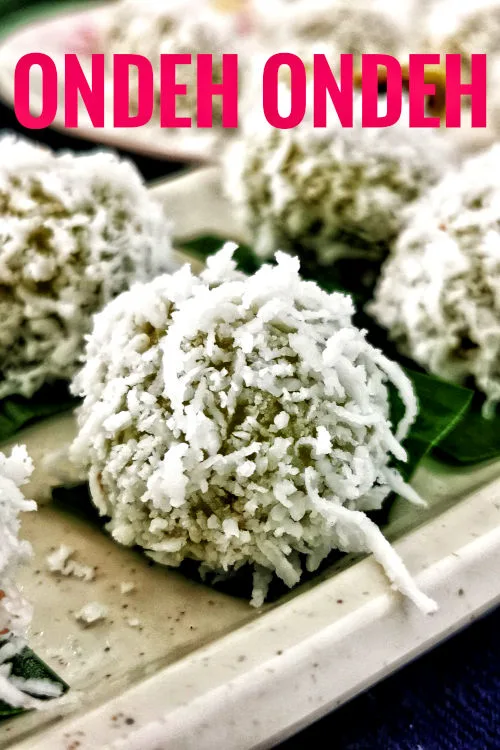
Note: This post may contain affiliate links. Please read my privacy policy for more info. I may receive commissions for purchases made through links in this post. As an Amazon Associate, I earn from qualifying purchases.
1. Make the Pandan extract
The pastry of the glutinous rice ball is flavored with pandan juice, making it green before being coated with grated coconut.
Pandan leaf is also called screwpine leaf in English, which is widely used to flavor a variety of desserts like vanilla leaves. Besides dessert, it is also an ingredient in cooking nasi lemak, ayam masak merah, and many more savory dishes.
However, fresh pandan leaves may not be available in every part of the world as they are tropical. You can substitute it with pandan extract or pandan paste if it is unavailable.
Here are the steps:
- Wash the pandan leaves, then cut them into short sections.
- Place them in a food processor or blender and add some water. I blend about 40g of pandan leaves from five large leaves plus one cup of water until they become thick suspensions. You can use fewer pandan leaves if you want, but more pandan leaves will give the ondeh ondeh a delightful aroma. The higher concentration also means that the green color is darker and does not need artificial coloring.
- Pour the suspension into a cloth bag, and squeeze out as much fresh pandan extract as possible.
If you use store-bought pandan extract, you may need to add some food color to make it look greener. Some extracts may even contain artificial flavoring agents (like vanilla extract). Please pay attention to the information on the label to get the natural extract, as it makes a massive difference in the flavor.
2. Prepare the palm sugar
Palm sugar (also called Gula Melaka and Gula Jawa locally) has a unique aroma and flavor, tastier than brown sugar. It is available in various forms, and the ones I have are round cylinder blocks. You can either cut or shave it to become small granules.
Some palm sugar blocks are quite hard, and others are softer. I would suggest pounding the palm sugar with a mortar and pestle if it is hard since it will take longer to melt inside the ondeh ondeh while boiling. The goal is to encase the molten palm sugar inside the dough, not the unmelted sugar pieces.
I also add a small castor sugar (about ten percent of palm sugar). The castor sugar is optional. You can omit it if you prefer less sweet (palm sugar is not as sweet as white sugar), then use palm sugar. Another option is to use brown sugar, but the taste will not be authentic.
3. Make the glutinous rice dough
The outer layer of the ondeh ondeh is made with glutinous rice flour. So please ensure that it is glutinous rice flour, not rice flour. You can get it from most Asian grocery stores as it is standard in Asian desserts.
Glutinous rice flour is quite sticky and becomes chewy when cooked. This texture makes people like ondeh ondeh and other Asian desserts prepared with glutinous rice flour. However, it can be challenging when wrapping the palm sugar in dough made with glutinous rice flour since it is sticky. Therefore, I have added two tablespoons of tapioca flour to make it less sticky and easier to handle. You can also use cornstarch or regular rice flour if tapioca flour is unavailable.
I also add a tablespoon of vegetable oil to the dough while kneading. Oil is an optional ingredient, but it helps form a more pliable dough and is less likely to crack while wrapping the sugar.
The dough is prepared by mixing the glutinous rice flour and tapioca flour, then adding the pandan extract slowly and kneading it. The final result should look like a plasticine with a shiny surface.
The amount of pandan extract is crucial because if the dough is too dry, it will crack while wrapping. On the contrary, it is too sticky to handle if too much extract is added. I have given the exact weight of the ingredients in the recipe that works well, but you may need to make some changes since the flour you use may not be the same as what I used.
Dusting your hand with flour while encasing the sugar inside the dough is also helpful, as it can be quite sticky.
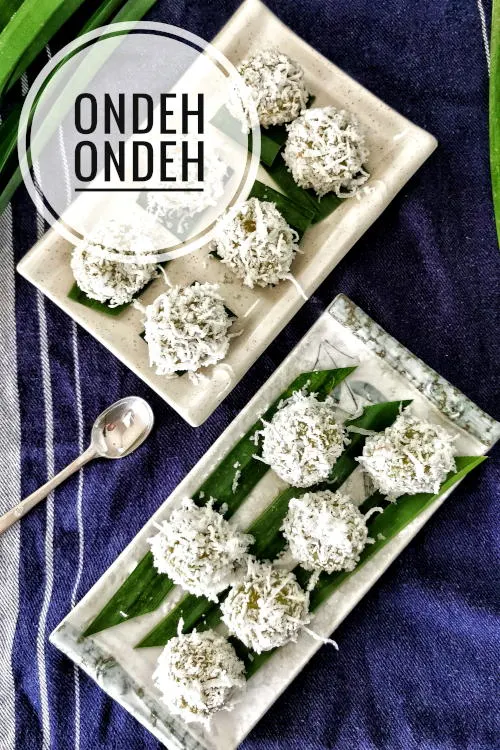
4. Wrap the ondeh ondeh
Ondeh ondeh is a bite-size dessert that should be small. I use about 12g of the dough to enclose about 3 grams (slightly more than 1/2 teaspoon) of sugar. Of course, you can use more sugar, but it can be more challenging to wrap.
Wrapping the palm sugar inside the soft dough is the only part that is a little tricky in this recipe. However, it is forgiving because the dough is malleable, like plasticine. The goal is to seal all the palm sugar filling inside the dough, then roll it with your palm to shape it into a small ball.
Once you have finished wrapping the ondeh ondeh, place the glutinous rice balls on a floured surface to prevent them from sticking.
5. Boil the ondeh ondeh
Bring a large pot of water to a boil and put the ondeh ondeh into the hot water. However, there are a few points you should take note of while cooking them.
- First, you should use low to medium heat to boil the ondeh ondeh. The goal is not only to cook the dough but also to ensure the palm sugar melts. If you boil them in water that boils vigorously, the dough will cook pretty fast, but the sugar inside is still not melted.
- Initially, all the ondeh ondeh or klepon balls will sink to the bottom. Please stir lightly to prevent them from sticking to the bottom. Once the surface starts to cook, it will no longer stick to the bottom for the rest of the cooking process. When they are cooked after four to five minutes, they will start to float on the surface.
- At this point, the sugar inside the dough balls has not melted yet. Therefore, you need to cook it further, as unmelted sugar granules inside don’t taste good. Since the exact time required depends on the size of the ondeh ondeh and the palm sugar (some brands of palm sugar dissolve faster than others), I would suggest dropping one or two ondeh ondeh into the water to test how long it takes before the sugar has melted. It usually takes eight to twelve minutes to get this result.
6. Coat with grated coconut
When the ondeh ondeh are cooked, remove them with a slotted spoon and immediately transfer them into a shredded coconut bed. The shredded coconut sticks better to the smooth balls when hot. The process is similar to coating the sponge cake with grated coconut while preparing Lamington.
The grated coconut is usually added with some salt to make it slightly salty, contrasting the sweetness of the palm sugar. Next, roll the ondeh ondeh in the bed of coconut to cover them thoroughly with the grated coconut. Now it is ready to serve.
Speaking about the grated coconut, I am fortunate to get the freshly grated coconut from an established coconut store that supplies coconut cream and grated coconut to many restaurants. She will open the fresh coconut and grate it on the spot.
It may not be the case for everyone, so you will likely use the desiccated coconut, which you can purchase from the supermarket, as a substitute.
Note: You can directly coat the ondeh ondeh with freshly grated coconut if you want to serve it immediately. However, if you intend to keep it longer, it is best to steam the grated coconut (which I did in the recipe) for five minutes to kill any possible germs so that it can last longer.
7. More tips about making ondeh ondeh
- You can prepare the dough ahead of time. When you need to use it, remove it from the refrigerator, then knead it for a minute before using it.
- Ondeh ondeh is best served immediately. If you intend to keep it longer, transfer it to an airtight container and keep it refrigerated for up to two days. Since ondeh ondeh will harden after chilling, you can reheat it by steaming it for a few minutes before serving. If you plan not to serve it immediately, do not roll them in the grated coconut; only do it after reheating.
- There are modern variants of the traditional recipe. Some variations include replacing the glutinous rice dough with yam, sweet potato, and pumpkin paste. There are also variants replacing palm sugar with chocolate. In addition, colorful ondeh ondeh can be created by adding food coloring to the dough, which is more appealing to kids.
Ondeh ondeh Recipe
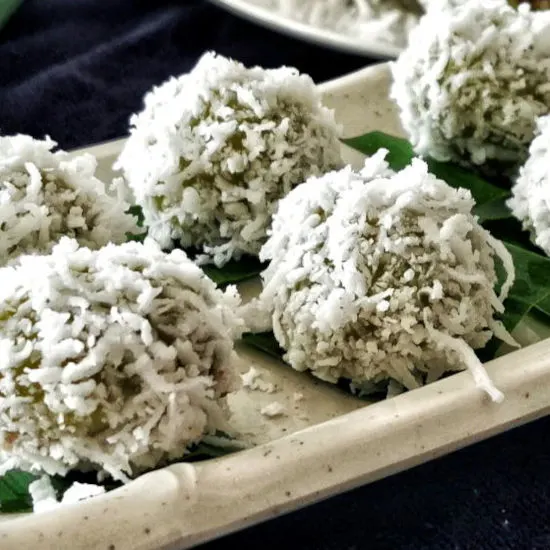
Ondeh ondeh is a sweet delicacy with palm sugar wrapped within a glutinous rice flour dough and coated with salted grated coconut.
Ondeh means little balls, and this name is more commonly used in Malaysia and Singapore. It is popular among the Malays and is also one of the Baba Nyonya delicacies.
Ingredients
- 6 pandan leaves (about 40g)
- 200 ml water (0.85 cup)
- 190g glutinous rice flour (6.7 oz)
- 2 tbsp tapioca flour
- 75g palm sugar (2.6 oz)
- 2 tsp caster sugar
- 200g grated coconut (7 oz)
- 1/2 tsp salt
Instructions
- Wash the pandan leaves, then cut them into short sections.
- Place them in a food processor or blender and add some water to blend the leaves until they become a thick suspension.
- Pour the pandan suspension into a cloth bag, and squeeze out as much extract as possible.
- Mix the glutinous rice flour, tapioca flour, and vegetable oil.
- Then add the pandan extract slowly and knead it to form a dough.
- Shave palm sugar into small pieces, then add castor sugar and pound it with mortar and pestle.
- Add the salt to the grated coconut. Mix well. Steam the grated coconut for five minutes.
- Divide the dough into 12 g portions, then wrap half a teaspoon of palm sugar in each of them. Roll each ondeh ondeh with your palm to shape it into a ball.
- Cook the ondeh ondeh in boiling water over medium heat for twelve minutes or until the sugar is melted.
- When the ondeh ondeh are cooked, remove them with a slotted spoon and transfer them immediately into a bed of grated coconut.
- Coat the ondeh ondeh with the grated coconut and serve.
Recommended Products
As an Amazon Associate and member of other affiliate programs, I earn from qualifying purchases.
-
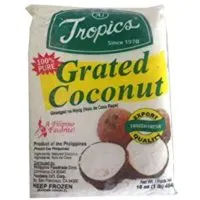 Frozen Grated Coconut - 16oz (Pack of 3)
Frozen Grated Coconut - 16oz (Pack of 3) -
 Iya's All Natural Tapioca Starch Flour (2.5 Lb. Bag) Grain-Free, Certified Gluten-Free, Non-GMO and Kosher. Made From 100% Yuca Root.
Iya's All Natural Tapioca Starch Flour (2.5 Lb. Bag) Grain-Free, Certified Gluten-Free, Non-GMO and Kosher. Made From 100% Yuca Root. -
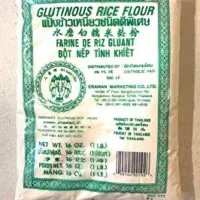 Glutinous Rice Flour 1 LB x 20 Bags 水磨白糯米𥺃粉
Glutinous Rice Flour 1 LB x 20 Bags 水磨白糯米𥺃粉 -
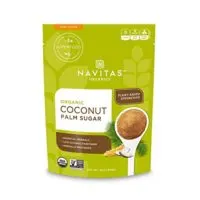 Navitas Organics Coconut Palm Sugar, 16 oz. Bag — Organic, Non-GMO, Gluten-Free, Sustainable
Navitas Organics Coconut Palm Sugar, 16 oz. Bag — Organic, Non-GMO, Gluten-Free, Sustainable
Nutrition Information:
Yield:
35Serving Size:
1Amount Per Serving: Calories: 47Total Fat: 2gSaturated Fat: 2gTrans Fat: 0gUnsaturated Fat: 0gCholesterol: 0mgSodium: 50mgCarbohydrates: 7gFiber: 1gSugar: 2gProtein: 1g
This data was provided and calculated by Nutritionix on 11/7/2021

KP Kwan
Monday 8th of November 2021
Hi, this is KP Kwan. I am happy to see you in this comment area, as you have read through my recipe. I am glad to reply to any questions and comments as soon as possible.